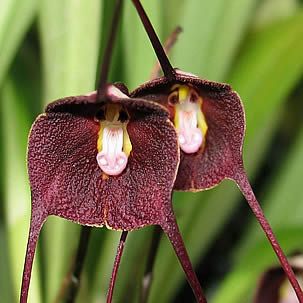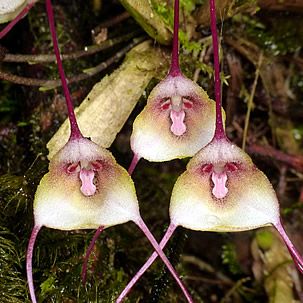Monkey orchid is the popular name given to orchids of the genus Dracula, which are notable for their flowers resembling the face of a monkey. The name Dracula refers to the mythical Count Dracula, the master of vampires. This name was chosen due to the red color of many species and the long extensions at the tips of the sepals, resembling the long canine teeth of a vampire. This genus includes about 122 species, the majority of which are endemic to the western side of the Andes mountain range, in areas of Colombia and Ecuador. They are epiphytic orchids, thriving in high humidity environments and growing at altitudes between 2,953 and 6,562 feet (900 and 2,000 meters).

The monkey orchid displays a clump-forming growth habit, creating a small clump. Its rhizome is short, climbing, and unlike many orchid species we know, it does not form pseudobulbs. Instead, each shoot has a single leaf, with a thin texture and a prominently marked central vein. It can bloom at any time of the year, with inflorescences having long stems, usually pendant or horizontal, and rarely upright. Typically, one to five buds emerge at a time per inflorescence, but flowering tends to be sequential, with one flower opening at a time and a long interval between them.
The flowers are triangular, clearly resembling the face of a primate. They are often colored red, orange, or brown and have long, characteristic extensions on the sepals. It is said to have the aroma of ripe orange. Although, to us, the flowers of this unique orchid resemble a monkey’s face, the primary goal in this genus is to mimic the appearance and scent of mushrooms, thereby attracting its main pollinator, a specific type of fly that seeks mushrooms for egg-laying.

As their flowers are generally pendant, it is interesting to cultivate them in baskets made of wooden slats designed for suspension, in a location where they can be admired from below or at eye level. They should not be planted in ceramic or plastic pots, as they tend to produce inflorescences through the drainage holes. If there is no way to flower from the bottom of the pot, the orchid often aborts the flowering. Monkey orchids are rare, demanding, and delicate, ideal for collectors and experienced orchid enthusiasts who can provide the type of environment and care required when away from their habitat.
They thrive in light shade, without direct sunlight, in a potting mix suitable for epiphytes, enriched with constantly moist sphagnum moss. This orchid appreciates high ambient humidity, so do not consider cultivating it in dry environments or areas subject to winds. Monkey orchids are very sensitive to the amount of dissolved salts in the water.
Therefore, always use settled and high-quality water for watering. Regularly fertilize with soluble fertilizers specifically for orchids, and thoroughly wash the substrate, irrigating abundantly with pure water between fertilizations, to remove excess salts. They prefer a cool, mild, and consistent climate, always below 77°F (25°C). Propagation is by dividing the clumps, ensuring each new division has a complete structure, as well as at least three leaves and a growing point.






